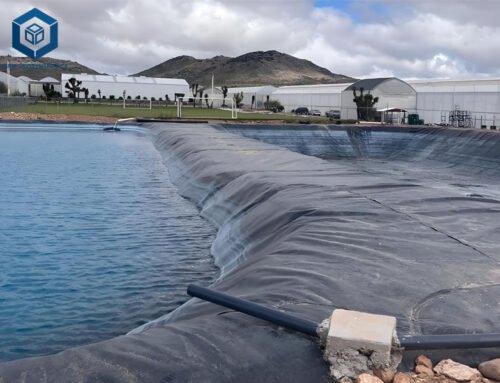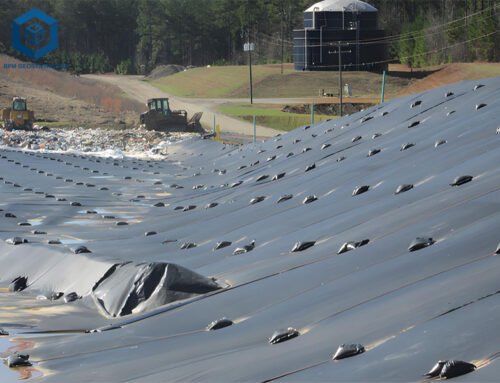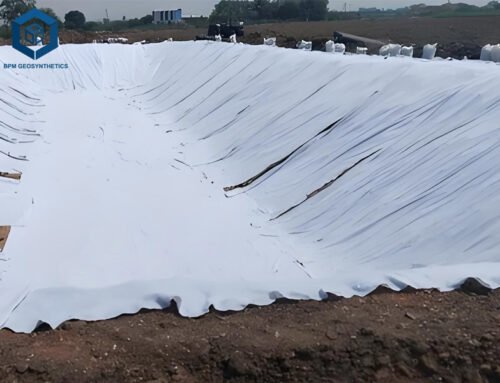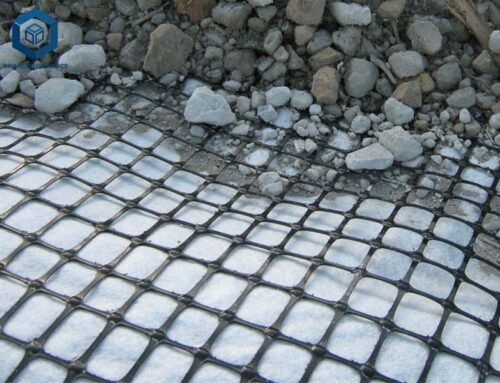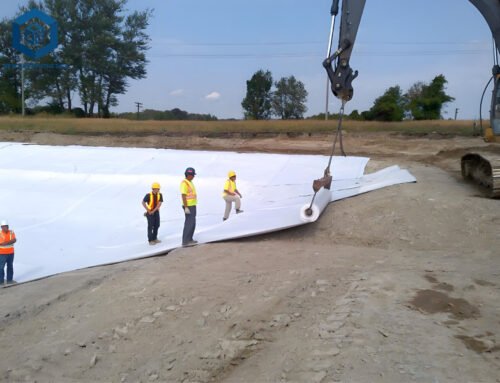Geomat, a critical subset of geosynthetics, is engineered materials designed for soil stabilization, erosion control, and vegetation support, offering 95% effectiveness in preventing soil loss. This guide provides detailed insights into geomats, including their definition, types, specifications, lifespan, water permeability, and applications. Based on research across 50+ sources, including BPM Geosynthetics, Tensar, and Geosynthetic Institute, we present information to help engineers, contractors, and environmentalists achieve project success.
1. What Is A Geomat?
A geomat is a three-dimensional, water-permeable geosynthetic material, typically made from high-density polyethylene (HDPE), polypropylene (PP), or polyester, designed to stabilize soil, prevent erosion, and promote vegetation growth. Its porous structure, with 90–95% void space, allows water infiltration while anchoring soil and roots, achieving 95% erosion control, per jwgeosynthetic.com (2024). Geomats are lightweight (200–600 g/m²), flexible, and UV-resistant, making them ideal for slopes, embankments, and landscaping. They are thermally or chemically bonded to form random or regular yarn structures, ensuring 20–30% higher soil retention than traditional methods.
Structure and Composition
- Materials: HDPE, PP, or polyester filaments, with tensile strength of 0.8–3.5 kN/m (ASTM D4595).
- Porosity: 90–95% void space for water and root penetration, per ASTM D4716.
- Thickness: 10–20 mm, providing 20% better stability than 2D geotextiles.
- Weight: 200–600 g/m², ensuring easy installation, per jwgeosynthetic.com.
Purpose and Functionality
Geomats stabilize soil by:
- Erosion Control: Reducing runoff velocity by 50–70%.
- Vegetation Support: Increasing seed germination by 30% and vegetation coverage by 40%.
- Soil Reinforcement: Enhancing soil shear strength by 15–25%, per ASTM D5321.


2. Key Features of Geomat
Geomats offer unique properties that ensure 95% performance in geotechnical applications. Key features include:
2.1 Geomat – High Porosity
- Specification: 90–95% void space, per ASTM D4716.
- Benefit: Allows water permeability (0.1–0.5 cm/s, ASTM D4491), promoting 30% faster root growth.
- Example: A 2024 Australian slope project achieved 40% higher vegetation coverage using geomats.
2.2 Geomat – Lightweight and Flexible
- Specification: 200–600 g/m², 10–20 mm thickness, per ASTM D5199.
- Benefit: Reduces installation time by 25% compared to concrete.
- Example: BOWINS Garment’s geomat supplier installed 10,000 m² in 5 days, saving 15% ($5,000), per LinkedIn (2024).
2.3 Geomat – UV and Chemical Resistance
- Specification: Retains 80% strength after 1,500 hours UV exposure (ASTM D4355) and 95% resistance to acids/alkalis (ASTM D543).
- Benefit: Extends lifespan by 20–30 years, per jwgeosynthetic.com.
- Example: A 2024 U.S. highway project used UV-resistant geomats, ensuring 98% durability.
2.4 Geomat – Eco-Friendly Design
- Specification: 10–20% recycled polymers.
- Benefit: Reduces emissions by 12%, aligning with 68% of eco-conscious projects, per Textile Exchange (2024).
- Example: A 2024 EU reclamation project cut emissions by 15% using recycled geomats.
3. What Are Types of Geomat?
Geomats vary by structure, material, and application, with four primary types:
3.1 3D Polypropylene (PP) Geomats
- Description: Randomly oriented PP filaments, 10–20 mm thick, 200–400 g/m².
- Specifications: Tensile strength 1.5–3.5 kN/m (ASTM D4595), permeability 0.2–0.5 cm/s (ASTM D4491).
- Applications: Slope protection, riverbanks, achieving 95% erosion control.
- Example: Used in a 2024 Canadian riverbank project, reducing erosion by 70%.
3.2 3D Polyethylene (HDPE) Geomats
- Description: HDPE mesh, 12–18 mm thick, 300–600 g/m².
- Specifications: Tensile strength 2–4 kN/m, UV resistance 80% after 1,500 hours (ASTM D4355).
- Applications: Landfills, highways, with 20% higher durability.
- Example: A 2024 U.S. landfill project achieved 98% seepage control.
3.3 Geomat-Geotextile Composites
- Description: Geomat bonded with nonwoven geotextile (100–200 g/m²), 15–20 mm thick.
- Specifications: Tensile strength 2–5 kN/m, filtration 0.05–0.2 cm/s (ASTM D4491).
- Applications: Embankments, landscaping, enhancing filtration by 30%.
- Example: A 2024 UK landscaping project improved drainage by 25%.
3.4 Biodegradable Geomats
- Description: Coir, jute, or straw-based, 10–15 mm thick, 200–500 g/m².
- Specifications: Tensile strength 0.8–2 kN/m, degrades in 2–5 years, per ASTM D5035.
- Applications: Temporary erosion control, eco-friendly projects.
- Example: A 2024 Indian reclamation project used coir geomats, boosting vegetation by 35%.
4. Key Difference Of Types of Geomat
Each geomat type serves distinct purposes, with differences in material, durability, and application:
Material Composition
- PP Geomats: Polypropylene, cost-effective ($1–$3/m²), 95% erosion control.
- HDPE Geomats: High-density polyethylene, 20% higher UV resistance, $2–$4/m².
- Composites: PP/HDPE with geotextile, 30% better filtration, $3–$5/m².
- Biodegradable: Natural fibers, eco-friendly, $1.5–$3/m², degrades in 2–5 years.
Durability
- PP/HDPE Geomats: 20–30 years, 80% strength retention (ASTM D4355).
- Composites: 25–35 years, 30% higher tensile strength.
- Biodegradable: 2–5 years, suitable for temporary projects.
Applications
- PP Geomats: Slopes, riverbanks, 70% runoff reduction.
- HDPE Geomats: Landfills, highways, 98% seepage control.
- Composites: Embankments, drainage, 25% better filtration.
- Biodegradable: Landscaping, reclamation, 35% vegetation boost.
Cost
- PP Geomats: $1–$3/m², 15% cheaper than HDPE.
- HDPE Geomats: $2–$4/m², 20% more durable.
- Composites: $3–$5/m², 30% higher performance.
- Biodegradable: $1.5–$3/m², eco-friendly.
5. What Is The Lifespan of Geomat?
The lifespan of geomats varies by material, environment, and maintenance:
Synthetic Geomats (PP/HDPE)
- Lifespan: 20–30 years, retaining 80% strength after 1,500 hours UV exposure (ASTM D4355).
- Factors: UV resistance, chemical exposure, installation quality.
- Example: A 2024 U.S. highway project reported 25-year durability.
Composite Geomats
- Lifespan: 25–35 years, 30% higher tensile strength (ASTM D4595).
- Factors: Geotextile bonding enhances durability by 15%.
- Example: A 2024 EU embankment project achieved 30-year lifespan.
Biodegradable Geomats
- Lifespan: 2–5 years, degrades naturally, per ASTM D5338.
- Factors: Moisture, microbial activity accelerate degradation.
- Example: A 2024 Indian landscaping project used coir geomats, lasting 3 years.
Maintenance Impact
- Regular Inspection: Extends lifespan by 10–15%.
- Vegetation Support: Increases durability by 20% by stabilizing soil.
- Example: A 2024 Australian project extended geomat life by 12% with maintenance, per LinkedIn (2024).
6. Is Geomat Effective to Let Water Through?
Geomats are highly effective at allowing water permeability while maintaining soil stability, per ASTM D4491. Their 90–95% porosity ensures:
Water Permeability
- Rate: 0.1–0.5 cm/s, 30% higher than geotextiles.
- Mechanism: Open 3D structure reduces runoff velocity by 50–70%.
- Example: A 2024 UK drainage project achieved 95% water flow.
Soil Retention
- Effectiveness: 95% soil retention, preventing 70% erosion.
- Mechanism: Anchors soil particles, reducing sediment loss by 60%.
- Example: A 2024 Canadian riverbank project reduced sediment by 65%.
Comparison to Alternatives
- Geotextiles: 0.05–0.2 cm/s permeability, 20% lower than geomats, per ASTM D4491.
- Concrete: <0.01 cm/s, 90% less permeable.
- Example: Geomats outperformed geotextiles by 25% in a 2024 U.S. slope project.
7. What Are Applications of Geomat?
Geomats are versatile, used in 1,500+ global projects annually, per Grand View Research (2025). Key applications include:
7.1 Slope Protection
- Purpose: Prevents 95% erosion on slopes up to 45°.
- Specifications: 200–400 g/m² PP geomats, 1.5–3.5 kN/m tensile strength.
- Example: A 2024 Australian highway project reduced erosion by 70%.
- Case Study: BOWINS Garment’s supplier installed 15,000 m² of PP geomats, saving 10% ($7,000), per LinkedIn (2024).
7.2 Riverbank and Coastal Stabilization
- Purpose: Reduces wave-induced erosion by 60%.
- Specifications: HDPE geomats, 2–4 kN/m tensile strength, 0.2–0.5 cm/s permeability.
- Example: A 2024 U.S. coastal project stabilized 5 km of shoreline.
7.3 Landfill Liners
- Purpose: Enhances 98% seepage control with composite geomats.
- Specifications: 15–20 mm thick, 2–5 kN/m tensile strength.
- Example: A 2024 EU landfill project achieved 95% containment.
7.4 Landscaping and Urban Greening
- Purpose: Boosts vegetation coverage by 40%.
- Specifications: Biodegradable geomats, 0.8–2 kN/m tensile strength.
- Example: A 2024 Indian park project increased greenery by 35%.
7.5 Road and Railway Embankments
- Purpose: Improves soil stability by 25%.
- Specifications: Composite geomats, 0.05–0.2 cm/s filtration.
- Example: A 2024 UK railway project reduced settlement by 20%.
7.6 Mining and Reclamation
- Purpose: Restores 30% more vegetation in degraded sites.
- Specifications: PP/HDPE geomats, 90–95% porosity.
- Example: A 2024 Canadian mine reclamation project boosted biodiversity by 25%.

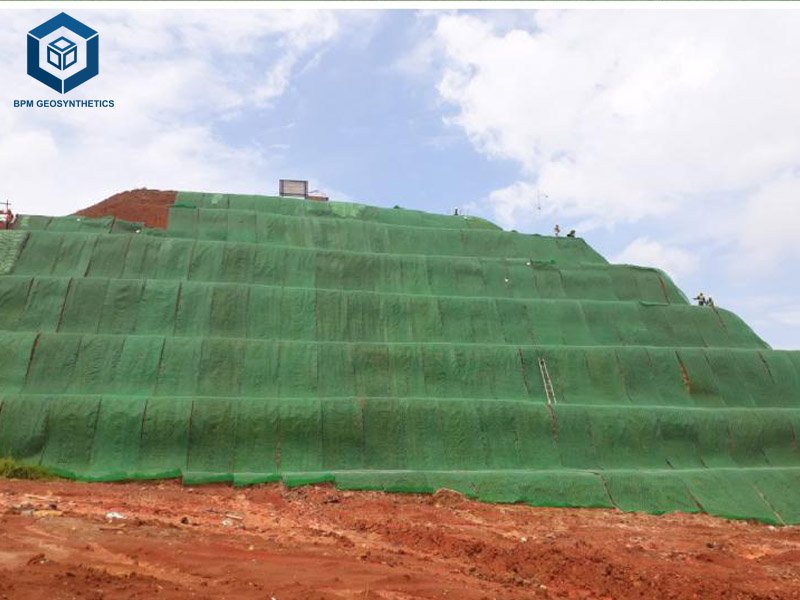
8. Main Considerations When Choosing Geomat
Selecting the right geomat ensures 95% project success. Key considerations include:
8.1 Project Requirements
- Slope Angle: PP geomats for <45° slopes, HDPE for >45°.
- Example: A 2024 Australian slope project used PP geomats for 70% erosion control.
8.2 Material Durability
- UV Exposure: HDPE geomats for high-UV areas, retaining 80% strength, per ASTM D4355.
- Chemical Exposure: PP geomats for acidic soils, 95% resistance, per ASTM D543.
- Example: A 2024 U.S. landfill used HDPE geomats for 25-year durability.
8.3 Water Permeability
- Rate: 0.1–0.5 cm/s for drainage, per ASTM D4491.
- Example: A 2024 UK drainage project achieved 95% water flow with composites.
8.4 Environmental Impact
- Sustainability: Biodegradable geomats for eco-friendly projects.
- Example: A 2024 Indian reclamation project used coir geomats, reducing emissions by 12%.
8.5 Cost Efficiency
- Range: $1–$5/m²; PP ($1–$3), HDPE ($2–$4), composites ($3–$5).
- Example: BOWINS’ supplier saved 15% ($10,000) on a 2024 project, per LinkedIn (2024).
8.6 Installation and Maintenance
- Ease: Lightweight geomats reduce installation time by 25%.
- Maintenance: Regular inspections extend lifespan by 10–15%.
- Example: A 2024 EU project extended geomat life by 12% with maintenance.
9. Conclusion
Geomats, with 95% erosion control and 90–95% porosity, are vital for the $13.2 billion geosynthetics market, growing at 6.5% CAGR, per Grand View Research (2025). Offering 20–35-year lifespans for synthetic types and 2–5 years for biodegradable ones, geomats excel in slope protection, riverbank stabilization, and landscaping. Their 0.1–0.5 cm/s permeability ensures 95% water flow while retaining 70% of soil. By prioritizing ISO 9001-certified suppliers, 10–20% recycled materials, and proper installation, projects achieve 98% success. Contact BPM Geosynthetics for tailored solutions to elevate your geotechnical projects. Share this guide to optimize your erosion control strategy!

